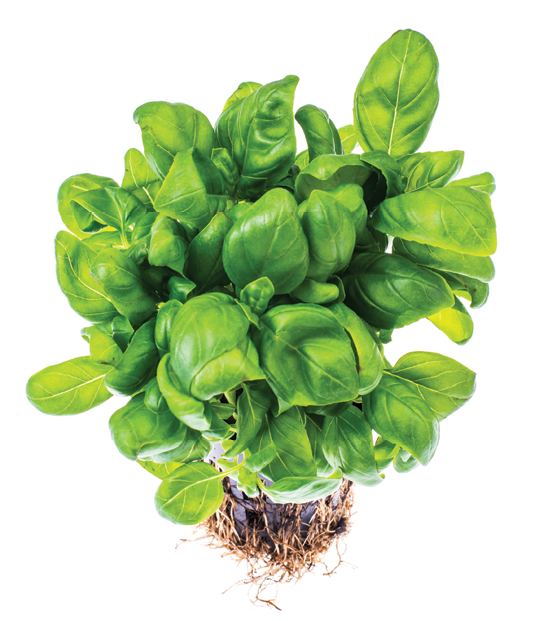
Welcome to iGrow News, Your Source for the World of Indoor Vertical Farming
Profits From Roots To Shoots
Today’s culinary consumer is looking for small, easy ways to add fresh, healthy ingredients to their daily lifestyle
Step Up Profits With Living Herbs And Greens.
May 28, 2019
Leslie F. Halleck
Fresh herbs and greens packaged with roots attached last two to three times longer than packaged fresh cut herbs — sometimes even longer.©ArtCookStudio | Adobe Stock
When it comes to the definition of “fresh,” it’s easy to get a wide variety of answers if you ask consumers. Some consumers consider prepared refrigerated foods as fresh, while others reserve the idea of freshness for the bulk produce aisle. For some, only organic produce qualifies as fresh, while others are happy to qualify anything green added to their diet as such — even if it’s conventional frozen produce. Varying definitions aside, there’s no denying the freshness of living herbs, greens and microgreens with roots still attached.
It used to be that fresh herb producers sought to garner market share from consumers purchasing dry packaged herbs. Now, there is new business to be captured in the fresh produce aisle. When it comes to positive sales trends, living herbs and lettuces offer many producers a way to grow.
Small steps to fresh
Today’s culinary consumer is looking for small, easy ways to add fresh, healthy ingredients to their daily lifestyle. That might mean a sprinkle of fresh basil on their pasta or a sprig of fresh thyme in their evening cocktail. These may seem like tiny steps for those of us who grow a lot of fresh produce, but they represent meaningful solutions for many consumers. There are just as many definitions of “cooking” as there are of “fresh” for that matter.
Fresh flavors
Why roots? Fresh herbs and greens packaged with roots attached last two to three times longer than packaged fresh-cut herbs — sometimes even longer in my experience, depending on how quickly you harvest all the foliage. This is a big benefit to both the retailers and the consumer.
For fresh herbs, recipe-ready varieties such as basil, rosemary, thyme and mint generally lead the pack. There isn’t much prep work needed to use these common herbs and most consumers are at least faintly familiar with how to use them. But as home cooks become more adventurous in their cooking styles, they’re open to more pungent and spicy flavors found in herbs such as cilantro and tarragon.
Well-rooted
Looking for a great example of how to make a go of packaged living herbs and greens? No need to look further than North Shore Greenhouses (northshore.farm). Under their trademarked North Shore Living brands, this southern California-based company hydroponically produces a wide array of living herbs and greens packed with roots attached. Using certified sustainable methods, North Shore has developed some seriously savvy packaging options for consumers, including self-watering mini-greenhouse packaging as well as “potted” options, which are essentially hydroponic baskets to support the plant roots. The potted options can be suspended in a jar or other water-holding containers, which make for a nice temporary windowsill herb garden.
North Shore has also done a great job on their website of providing instructions for how to store their living herbs and greens, as well as a bevy of tasty recipes to keep the end-user engaged. Their basil ice cream recipe is to die for. Yes, basil ice cream. Personally, I like to add a bit of lemongrass to brighten the flavor.
Not convinced?
A common knee-jerk concern with selling living fresh herbs and greens — roots attached — is that the consumer will just plant it up and not buy more. While you may have a few motivated gardeners who’ll take up the DIY task, most culinary customers will be very happy to maintain their living herbs or greens in the refrigerator, or in a glass jar on the countertop (or refrigerator) for a week or two — until it’s fully harvested. That’s more green than they usually get to have in their kitchen. When they’ve harvested it all, they’ll buy it again. Many apartment or small home dwellers may not have the option of permanently planting up their living herbs and greens, but are happy to have a fresh living specimen even temporarily.
Also, herbs and greens grown hydroponically, without soil, don’t always transition to containers or the garden successfully. So, your less-experienced or brown-thumb customers won’t always be successful with planting living greens and herbs. They really are better off keeping them in the fridge or on the countertop or windowsill.
More basil please!
I think packaged living basil is the ideal way for most culinary consumers to buy and use fresh basil from the grocery store, specifically since it’s damaged at temperatures below 40° F. That means most home refrigerators are a death zone for fresh basil (roots or no roots). I’m sure many customers have given up on fresh-packed cut basil after sticking it in the refrigerator, only to find that it has blackened and wilted the next day. Rooted plants on the countertop are the way to go.
If you already grow fresh-cut produce or herbs, or you’re a hydroponic grower who’s looking to expand your offerings, now is a great time to survey your local or regional market for opportunities. Living herbs and greens could be the perfect way to freshen up your produce profits.
Leslie (CPH) owns Halleck Horticultural, LLC, through which she provides horticultural consulting, business and marketing strategy, product development and branding, and content creation for green industry companies. lesliehalleck.com
Herbs Basil Root health Root crops Rosemary



